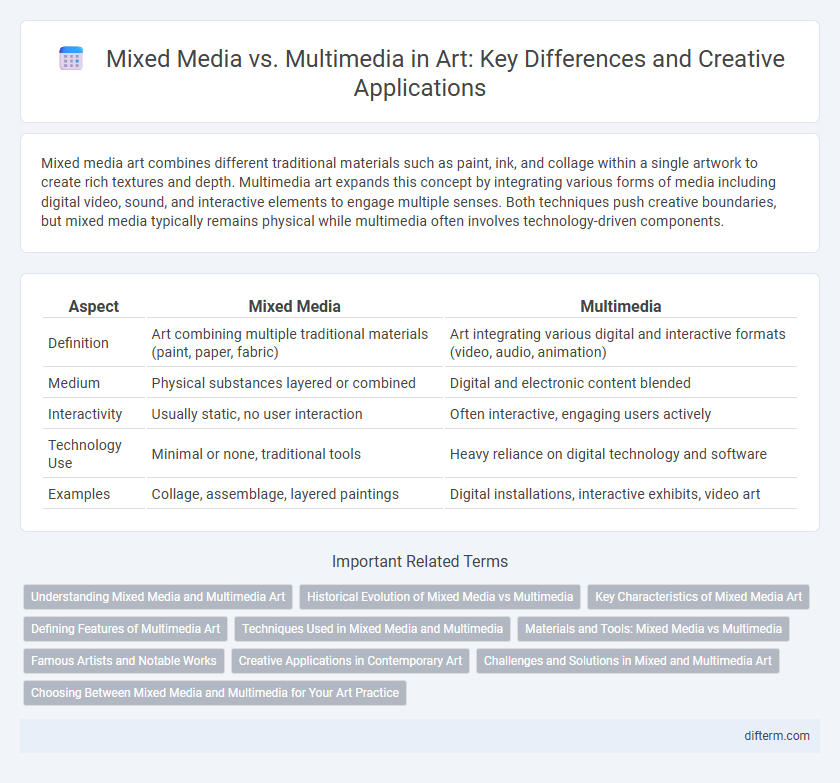Mixed media art combines different traditional materials such as paint, ink, and collage within a single artwork to create rich textures and depth. Multimedia art expands this concept by integrating various forms of media including digital video, sound, and interactive elements to engage multiple senses. Both techniques push creative boundaries, but mixed media typically remains physical while multimedia often involves technology-driven components.
Table of Comparison
| Aspect | Mixed Media | Multimedia |
|---|---|---|
| Definition | Art combining multiple traditional materials (paint, paper, fabric) | Art integrating various digital and interactive formats (video, audio, animation) |
| Medium | Physical substances layered or combined | Digital and electronic content blended |
| Interactivity | Usually static, no user interaction | Often interactive, engaging users actively |
| Technology Use | Minimal or none, traditional tools | Heavy reliance on digital technology and software |
| Examples | Collage, assemblage, layered paintings | Digital installations, interactive exhibits, video art |
Understanding Mixed Media and Multimedia Art
Mixed media art combines different traditional art materials such as paint, ink, and collage within a single artwork to create unique textures and visual effects. Multimedia art integrates various forms of media including audio, video, digital elements, and performance, offering an interactive and immersive experience. Understanding the distinction helps artists select techniques that best express their conceptual vision and engage audiences across sensory dimensions.
Historical Evolution of Mixed Media vs Multimedia
The historical evolution of mixed media dates back to early 20th-century avant-garde movements like Cubism and Dada, where artists combined traditional materials such as paint, paper, and fabric to challenge conventional art forms. Multimedia emerged later in the late 20th century with the advent of digital technology, integrating various forms of content including video, sound, and interactive elements to create immersive experiences. While mixed media emphasizes the physical layering of diverse materials, multimedia expands this concept by incorporating digital and electronic components for a broader sensory impact.
Key Characteristics of Mixed Media Art
Mixed media art combines various traditional art materials such as paint, ink, and collage elements on a single surface, emphasizing texture, depth, and tactile qualities. This approach enables artists to layer diverse physical media, creating rich, complex compositions that engage multiple senses. Unlike multimedia art, which integrates digital and electronic components like video or sound, mixed media remains rooted in tangible, handcrafted techniques.
Defining Features of Multimedia Art
Multimedia art integrates various content forms such as text, audio, images, animations, and video to create immersive and interactive experiences. Its defining features include the seamless combination of digital and traditional media, user engagement through interactivity, and the use of technology to convey complex narratives or concepts. Unlike mixed media, which primarily involves combining physical materials, multimedia art leverages digital platforms to expand sensory dimensions and audience participation.
Techniques Used in Mixed Media and Multimedia
Mixed media art combines various traditional materials such as paint, ink, collage elements, and fabric on a single canvas, emphasizing tactile layering and texture. Multimedia art integrates digital techniques like video, sound, animation, and interactive components alongside physical elements to create immersive experiences. Both techniques explore sensory engagement but differ in the balance of analog and digital processes used to convey artistic concepts.
Materials and Tools: Mixed Media vs Multimedia
Mixed media art combines different traditional materials such as paint, ink, fabric, and collage elements into a single artwork, emphasizing physical texture and layering techniques. Multimedia involves the integration of digital tools like video, sound, animation, and interactive technology alongside physical components to create dynamic, sensory experiences. Artists select specific tools and materials based on the desired tactile complexity for mixed media or the immersive, interactive potential in multimedia projects.
Famous Artists and Notable Works
Mixed media art, exemplified by Pablo Picasso's "Still Life with Chair Caning," involves combining different traditional materials such as paint, fabric, and paper within a single composition. Multimedia art expands this concept by integrating diverse forms, including audio, video, and digital elements, as seen in Nam June Paik's groundbreaking video installations like "TV Buddha." Both art forms push the boundaries of creativity, blending techniques to produce innovative sensory experiences.
Creative Applications in Contemporary Art
Mixed media in contemporary art involves combining various traditional materials like paint, ink, and fabric on a single canvas to create textured, layered compositions. Multimedia integrates diverse digital elements such as video, sound, and interactive components, expanding creative applications beyond physical boundaries. Artists leverage mixed media for tactile expression and multimedia for immersive experiences, pushing conceptual and sensory limits in modern artistic practices.
Challenges and Solutions in Mixed and Multimedia Art
Mixed media art often faces challenges in material compatibility and durability, requiring artists to experiment with adhesives, sealants, and layering techniques to ensure cohesion and longevity. Multimedia art encounters obstacles related to technology integration, such as software updates and hardware failures, prompting creators to adopt adaptable platforms and backup systems. Both forms benefit from innovative problem-solving strategies that balance artistic vision with practical functionality to overcome these diverse challenges.
Choosing Between Mixed Media and Multimedia for Your Art Practice
Choosing between mixed media and multimedia for your art practice depends on the materials and tools you prefer; mixed media combines different physical materials like paint, fabric, and paper, while multimedia integrates digital elements such as video, sound, and interactive components. Artists prioritizing tactile textures and traditional methods often lean towards mixed media, whereas those seeking to incorporate technology and digital innovation favor multimedia. Understanding your creative goals and the sensory experience you want to deliver guides the decision to blend physical and digital art forms effectively.
mixed media vs multimedia Infographic

 difterm.com
difterm.com